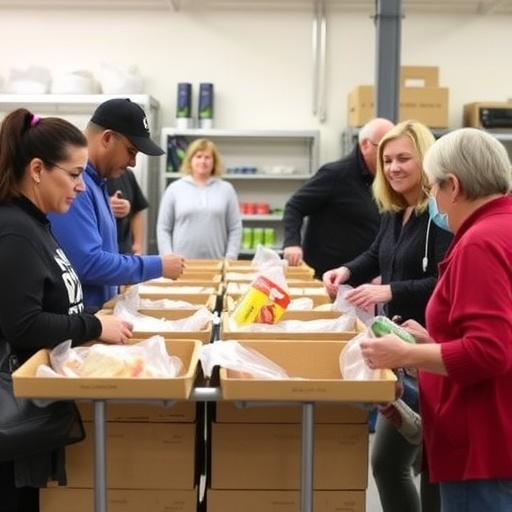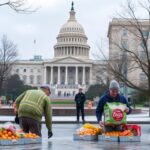Capital Area Food Bank Launches Weekly Food aid for Federal Employees Facing Government Shutdown Hardships
In a swift move to combat the growing financial desperation among federal employees hit hard by the ongoing government shutdown, the Capital Area Food Bank has rolled out emergency Food aid distributions. Starting this week, affected workers and contractors can access boxes brimming with pantry staples and fresh produce at multiple locations, simply by flashing their government ID. This initiative arrives at a critical juncture, as the shutdown—now stretching into its third week—leaves hundreds of thousands without paychecks, pushing many toward the brink of food insecurity.
- Shutdown’s Ripple Effects Hit Federal Workers Hardest in D.C. Region
- Weekly Distributions Expand to Key Metro Locations for Easy Access
- Federal Employees Navigate Eligibility and Unpack Program Benefits
- Community Partnerships Amplify Food Bank’s Shutdown Response
- Prolonged Shutdown Prompts Calls for Expanded Aid and Policy Reforms
The program, dubbed “Shutdown Support Network,” underscores the food bank’s role as a frontline responder in times of national crisis. With over 800,000 federal workers nationwide facing furloughs or unpaid leave, the Capital Area Food Bank is targeting the D.C. metro area, where the impact is most acute. Officials estimate that up to 40,000 local federal employees could benefit, providing a lifeline amid reports of skipped meals and mounting bills.
Shutdown’s Ripple Effects Hit Federal Workers Hardest in D.C. Region
The government shutdown, triggered by partisan disputes over funding and border security, has frozen pay for non-essential federal personnel while essential workers labor without compensation. In the nation’s capital, the effects are magnified: federal employees make up a significant portion of the workforce, and their sudden income loss reverberates through local economies. According to a recent survey by the National Treasury Employees Union, nearly 70% of affected federal employees report dipping into savings or taking on debt to cover basic needs like groceries and rent.
One such story comes from Sarah Jenkins, a 42-year-old IRS auditor from Alexandria, Virginia, who was furloughed two weeks ago. “I’ve never had to worry about putting food on the table before,” Jenkins shared in an interview with our news team. “But with two kids and a mortgage, every dollar counts. This food bank assistance feels like a godsend—it’s not just food; it’s dignity preserved.” Her experience echoes the sentiments of thousands, as food pantries nationwide report a 25% uptick in demand from government workers since the shutdown began.
Statistics paint a stark picture. The U.S. Department of Agriculture notes that food insecurity rates could spike by 15% in shutdown-affected areas, with families relying on emergency assistance programs like SNAP facing delays due to understaffed federal offices. In the D.C. area alone, the Capital Area Food Bank distributed over 1.2 million meals last year; this year, they’re bracing for a surge, partnering with local warehouses to stockpile non-perishables and seasonal produce.
Historically, food banks have stepped up during past shutdowns. During the 2018-2019 impasse, which lasted 35 days, similar initiatives prevented widespread hunger among federal families. Today, with the current shutdown showing no signs of resolution, the pressure is on to scale up quickly. The food bank’s CEO, Nancy Roman, emphasized this urgency: “We’re not waiting for Washington to act. Our emergency assistance is about immediate relief for those serving the public, now in need themselves.”
Weekly Distributions Expand to Key Metro Locations for Easy Access
To ensure broad reach, the Capital Area Food Bank has scheduled weekly food distributions at five strategic sites across the Washington, D.C., Maryland, and Virginia suburbs. The first event kicked off Monday at the food bank’s main facility in Northeast D.C., where lines formed early despite chilly morning temperatures. Participants received 20-pound boxes containing essentials like rice, canned beans, pasta, and fresh items such as apples, carrots, and leafy greens—enough to feed a family of four for a week.
Upcoming locations include:
- Arlington Community Center, Virginia: Tuesdays, 10 a.m. to 2 p.m., targeting Pentagon-area workers.
- Silver Spring Senior Center, Maryland: Wednesdays, focusing on USDA and NIH employees.
- National Harbor Warehouse, Maryland: Thursdays, with shuttle services from nearby Metro stops.
- Capital Area Food Bank Main Hub, D.C.: Fridays and Saturdays, open to all verified federal affiliates.
Each site is equipped with volunteers trained to handle high volumes, and distribution times are staggered to avoid overcrowding. “We’ve mapped these spots based on federal workforce density,” explained program coordinator Mia Gonzalez. “Our goal is zero barriers—show your ID, and walk away with Food aid that restores some normalcy.” Early feedback highlights the program’s efficiency; at the inaugural event, over 500 boxes were handed out in under four hours, with no reported incidents.
Beyond logistics, the food bank is incorporating health-focused elements. Boxes include nutrition guides tailored for busy families, emphasizing balanced meals to combat shutdown-induced stress eating. Collaborations with local farms ensure a steady supply of fresh produce, countering the 30% rise in grocery prices amid supply chain strains from the government shutdown.
For contractors, who often fall through federal safety nets, the program offers a flexible verification process. “Many of our supporters are private-sector partners of the government,” Gonzalez noted. “We’re verifying through work badges or pay stubs to include them in this emergency assistance.” This inclusivity addresses a gap, as contractors represent about 20% of the federal ecosystem and face similar pay disruptions.
Federal Employees Navigate Eligibility and Unpack Program Benefits
Accessing the food aid is straightforward but requires proof of federal affiliation to prioritize those most impacted. Eligible participants include active or furloughed federal employees, military reservists on unpaid status, and government contractors with valid credentials. A government-issued ID, such as a federal badge or Common Access Card (CAC), is mandatory at check-in. No income verification is needed, recognizing the uniform financial hit across pay grades.
What’s inside the boxes? Each distribution features a curated mix designed for versatility and nutrition:
- Pantry Staples: Canned vegetables, tuna, peanut butter, and whole grains to build affordable meals.
- Fresh Produce: Seasonal fruits and veggies, sourced from regional partners to promote healthy eating.
- Household Essentials: Limited supplies of toiletries and baby formula for families with young children.
- Specialty Items: Gluten-free or halal options available upon request, ensuring cultural sensitivity.
The value per box averages $50-$75 at retail prices, a significant saving for households averaging $1,200 in lost monthly income during the shutdown. Testimonials from recipients like Jenkins highlight the emotional boost: “Opening that box felt like reopening my wallet. It buys us time to focus on job security rather than hunger.”
Challenges persist, however. Some remote federal workers express frustration over location access, prompting the food bank to explore pop-up events and delivery partnerships with ride-share services. Additionally, mental health resources are bundled in, with QR codes linking to counseling hotlines—acknowledging the toll of financial uncertainty on well-being.
From a policy angle, advocates argue this emergency assistance exposes flaws in federal support systems. The Federal Employees’ Compensation Act provides backpay post-shutdown, but interim aid like this food bank program fills a vital void. As one union rep put it, “It’s a band-aid on a broken bone, but it’s something until Congress fixes the fracture.”
Community Partnerships Amplify Food Bank’s Shutdown Response
The Capital Area Food Bank’s efforts aren’t solo; a web of partnerships is amplifying the emergency assistance reach. Local supermarkets like Giant Food and Safeway have donated surplus inventory, while tech giants such as Amazon are providing logistics support for distributions. Nonprofits including Feeding America and the Greater Washington Community Foundation are chipping in funds, raising over $500,000 in the first week alone.
Corporate involvement adds layers: Boeing, a major government contractor, matched employee donations dollar-for-dollar, funneling resources directly to affected federal employees. Meanwhile, faith-based groups like the Catholic Charities are hosting satellite events, blending spiritual support with practical food aid. “This is a collective call to action,” said Roman. “The shutdown tests our community’s resilience, and we’re rising together.”
On the ground, volunteer turnout has been overwhelming—over 300 sign-ups in 48 hours, including off-duty federal workers lending a hand. This peer-to-peer dynamic fosters solidarity; one volunteer, a NOAA meteorologist, remarked, “Helping others in the same boat reminds us we’re not alone in this storm.” Such stories humanize the crisis, turning statistics into shared narratives.
Broader data from the Center on Budget and Policy Priorities reveals that shutdowns exacerbate inequality, with lower-wage federal employees—like administrative staff and custodians—hit hardest. The food bank’s program counters this by offering equal access, but experts call for systemic changes, such as mandatory emergency funds in federal budgets. In the interim, these partnerships ensure the aid flows uninterrupted, even as political stalemates drag on.
Economic ripple effects are notable too. Local farmers benefit from produce contracts, injecting $100,000 into regional agriculture weekly. This circular support model not only feeds families but sustains the very communities buoyed by federal presence.
Prolonged Shutdown Prompts Calls for Expanded Aid and Policy Reforms
As the government shutdown enters uncharted territory, potentially surpassing the 1995-1996 record of 21 days, the Capital Area Food Bank’s initiative signals a blueprint for sustained response. Plans are underway to double distribution capacity if the impasse lasts into next month, with mobile units targeting underserved areas like rural Virginia outposts. Funding appeals continue, urging public donations via the food bank’s website to keep shelves stocked.
Looking forward, implications extend beyond immediate relief. This crisis has spotlighted vulnerabilities in the federal workforce, prompting bipartisan murmurs of reform. Proposals include a “shutdown buffer fund” to automate pay during lapses, reducing reliance on charities like food banks. For now, the program offers hope: Jenkins plans to volunteer once backpay arrives, closing the loop on support.
Ultimately, as negotiations in Congress intensify, the resilience of federal employees shines through. With emergency assistance like this bridging the gap, families hold steady, awaiting resolution. The food bank’s message is clear: hunger won’t define this shutdown—community will.










